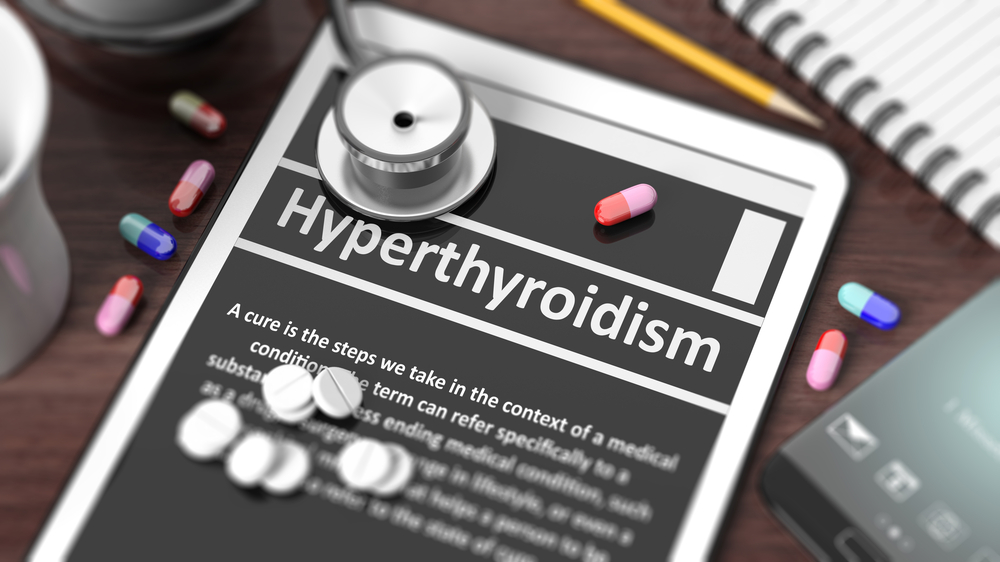Overview
The thyroid is a small butterfly-shaped gland in the neck, just in front of the windpipe. It produces hormones that regulate your heart rate and body temperature.
Hyperthyroidism is when the gland creates too much thyroid hormone- also called overactive thyroid. It can occur to anyone but is ten times more common in women and typically happens between 20-40 years old.
Key Facts
- Women are more likely than men to have hyperthyroidism
- Stress and other factors can worsen hyperthyroidism
- Early diagnosis and treatment are critical to managing symptoms and health outcomes.
- An overactive thyroid is usually treatable
Symptoms
Symptoms can be wide-ranging, can appear gradually or suddenly, and the impact on each individual also varies::
- Nervousness, anxiety and irritability
- Mood swings
- Persistent tiredness and weakness
- Sensitivity to heat
- Difficulty sleeping
- Swelling in your neck from an enlarged thyroid gland
- Irregular and/or high-speed heart rate
- Weight loss
- Hyperactivity
- Diarrhoea
- Needing to pee more often than usual
- Persistent thirst
- Sensitivity to heat
Diagnosis
If you experience these symptoms, speak with your doctor, who will take a complete health history and conduct a blood test to check your thyroid hormone levels.
The test checks the levels of the following elements:
- Thyroid-stimulating hormone (TSH) – this is a hormone produced by the pituitary gland, which is located at the base of your brain and controls the production of thyroid hormones
- Triiodothyronine (commonly referred to as T3) – is one of the main thyroid hormones
- Thyroxine (also known as T4) – this is another of the main thyroid hormones
Your thyroid hormone level results will be compared to normal for a healthy person of your age. If you have a low level of TSH and high levels of T3 and/or T4, it usually means you have an overactive thyroid.
Other blood tests may be conducted to help identify potential causes of the overactive thyroid and its impact on your body. This will help evaluate the best course of treatment for you. A scan may also be conducted to explore potential lumps or other problems on your thyroid.
Causes
The thyroid can become overactive because of underlying health conditions or changes to the thyroid. These can include:
- Graves’ disease is a health condition where your immune system mistakenly attacks and damages the thyroid. About 3 in every four people with an overactive thyroid have Graves’ disease.
- Lumps, also called nodules, on the thyroid – these lumps of extra thyroid tissue can produce more thyroid hormones which cause the hormone levels then become too high.
- Medications such as amiodarone, which is used to treat an irregular heartbeat
Prevention
Unfortunately, In most cases, hyperthyroidism cannot be prevented. It can be passed through a family with conditions such as Graves’ disease or when your body produces an increase in thyroid hormone, for example, during or after pregnancy.
Typical Treatments
An overactive thyroid is usually treatable. The main treatments are:
- Medication that stops your thyroid from producing too many hormones
- Radioiodine treatment: this is a type of radiotherapy which is used to destroy some cells in the thyroid, reducing the ability of the thyroid to produce excessive hormones
- If these don’t work, surgery may be recommended to remove some or all of it so that it no longer produces excessive hormones.
Your doctor and specialist (an endocrinologist) will discuss the best options for your situation.
Conclusion
An overactive thyroid is usually treatable. The long-term outlook for hyperthyroidism depends on its cause. Early diagnosis and treatment improve the long-term outlook.
MOST COMMON







